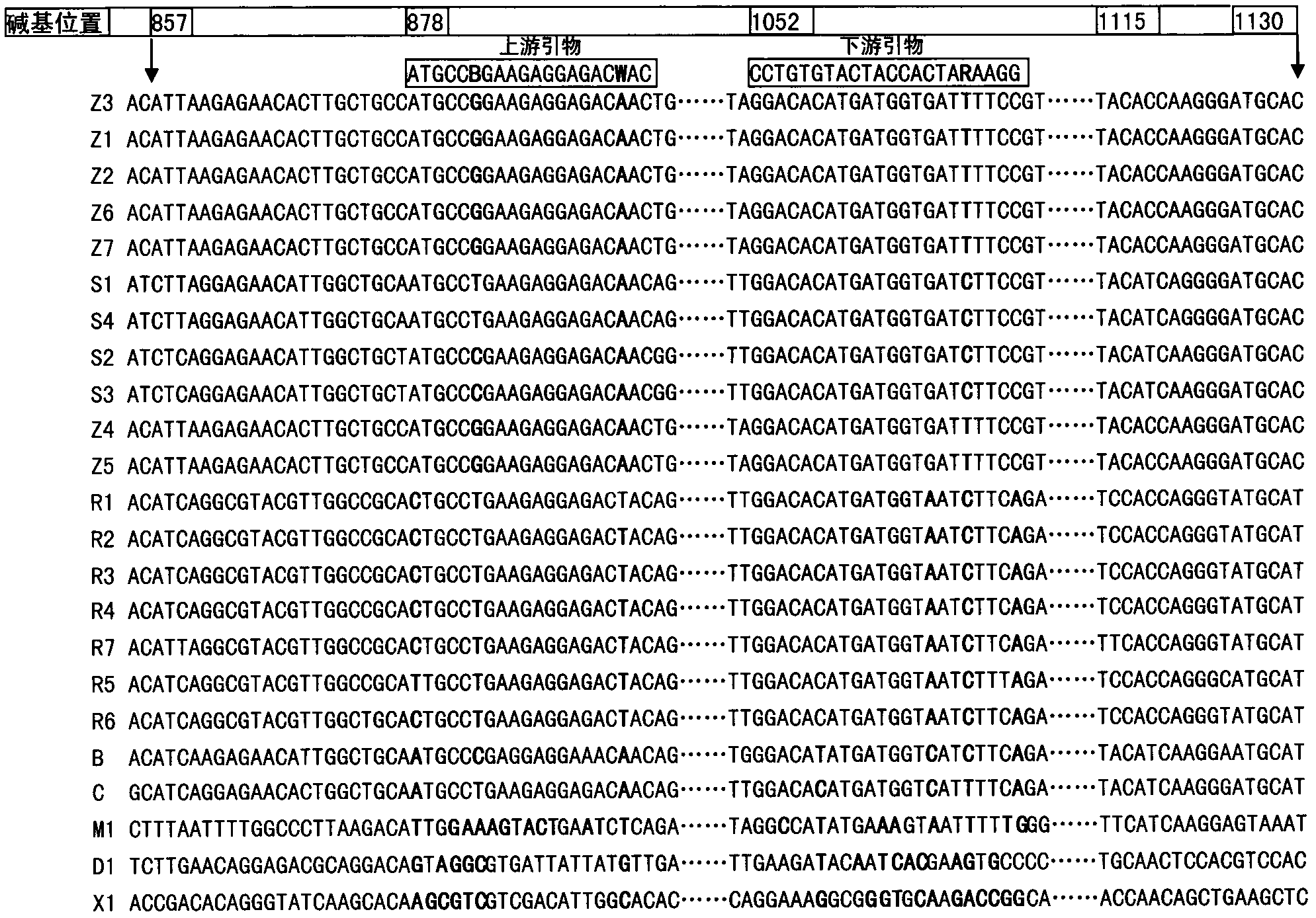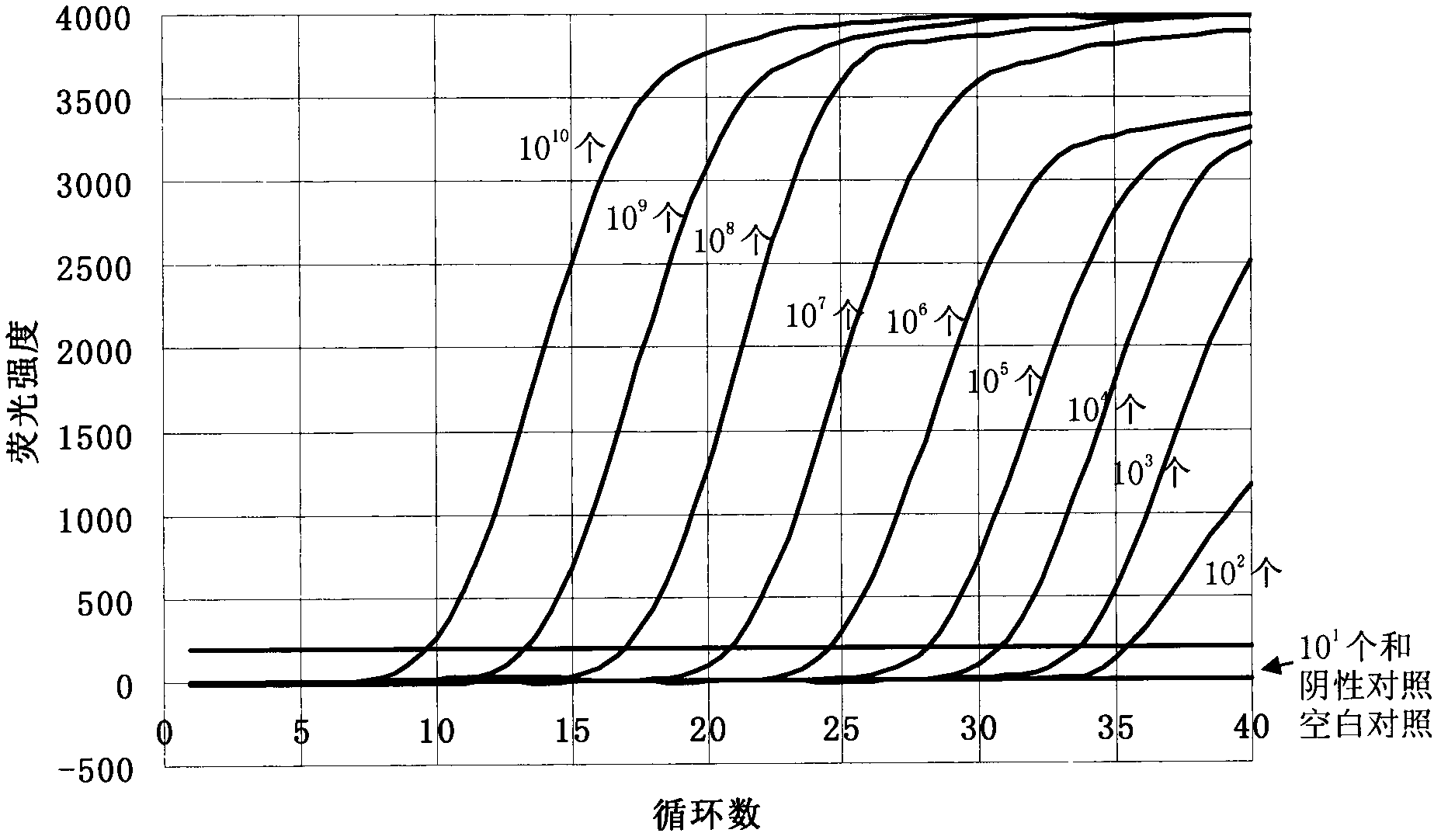Fluorescent quantitative PCR (polymerase chain reaction) method, primer and kit for detecting EBOV (Ebola virus)
An Ebola virus, fluorescence quantitative technology, applied in microorganism-based methods, biochemical equipment and methods, microorganisms, etc., can solve the problem of no patent publication of EBOV detection technology, achieve stable source, increase safety, and save time Effect
- Summary
- Abstract
- Description
- Claims
- Application Information
AI Technical Summary
Problems solved by technology
Method used
Image
Examples
Embodiment 1
[0058] Example 1 Primer Design
[0059] 1. Experimental steps
[0060] EBOV SYBR Green I fluorescent quantitative PCR primers refer to: oligonucleotide chains with a length of 25±5nt, which are completely identical or complementary to the NP gene sequences of the five subtypes of EBOV viruses Z, S, B, C, and R.
[0061] According to the NP gene sequences of EBOV, MARV, XFHV, and DHFV published in the NCBI gene database (reference strain information is shown in Table 1), the primer and probe design software Primer Express 2.0 (Applied Biosystems, USA) was used to design a pair of Z, S, B, C, R 5 subtype specific primers of EBOV. The primer sequences are shown in Table 2, and the primer gene positions in Table 2 refer to the positions on the gene of Zaire Ebola virus strain Mayinga (NCBI accession number AF499101.1). The results of comparing the designed primers with the corresponding gene sequences of EBOV, MARV, XFHV, and DHFV are shown in figure 1 .
[0062] Table 1. Stra...
Embodiment 2
[0069] The preparation of embodiment 2RNA positive standard molecule and negative standard molecule
[0070] 1. Experimental steps
[0071] 1. Five subtypes of EBOV, as well as Marburg virus (marburgvirus, MARV), dengue virus (dengue virus, DHFV), Xinjiang hemorrhagic fever virus (xinjiang hemorrhagic fever virus, XHFV) (see Table 3 for reference strains), according to The sequence indicated by the accession number was completely artificially synthesized by Nanjing Jinsite Technology Co., Ltd. for their full-length NP gene cDNA. MARV, XHFV, and DHFV were used as negative standard molecules.
[0072] Table 3. The strain information of artificially synthesized full-length NP gene cDNA reference
[0073]
[0074] 2. Design synthetic primers according to Example 1 (see Table 1), extend outwards to 273nt respectively along the primer amplification region of the EBOV NP gene sequence, design upstream primers and downstream primers connected to the T7 promoter sequence, and the ...
Embodiment 3
[0084] The extraction of embodiment 3 sample RNA
[0085] 1. Experimental steps
[0086] Tissue sample processing: Take about 100 mg of the tissue sample to be tested (such as liver and kidney), put it into a grinder, add 1000 μL of DEPC water, and grind. Take 100 μL of the supernatant of the tissue to be tested that has been ground, put it in a 1.5 mL sterilized centrifuge tube, add 1000 μL Trizol, mix well, and let it stand for 10 min.
[0087] Liquid sample processing: Take 100 μL of the liquid sample to be tested (such as blood, physiological saline dilution of nasal swab, and physiological saline dilution of respiratory secretions), put it in a 1.5 mL sterilized centrifuge tube, add 1000 μL Trizol, mix well, Let stand for 10min. Add 200μL of chloroform, shake vigorously for 15s, let stand at room temperature for 2-3min, and centrifuge at 12000g for 15min at 4°C. Carefully pipette 450 μL of the supernatant into another clean 1.5 mL centrifuge tube free of DNase and RNas...
PUM
 Login to View More
Login to View More Abstract
Description
Claims
Application Information
 Login to View More
Login to View More - R&D
- Intellectual Property
- Life Sciences
- Materials
- Tech Scout
- Unparalleled Data Quality
- Higher Quality Content
- 60% Fewer Hallucinations
Browse by: Latest US Patents, China's latest patents, Technical Efficacy Thesaurus, Application Domain, Technology Topic, Popular Technical Reports.
© 2025 PatSnap. All rights reserved.Legal|Privacy policy|Modern Slavery Act Transparency Statement|Sitemap|About US| Contact US: help@patsnap.com



